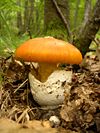| Saffron ringless amanita | |
|---|---|

| |
| Amanita crocea from Commanster, Belgium | |
| Scientific classification | |
| Domain: | Eukaryota |
| Kingdom: | Fungi |
| Division: | Basidiomycota |
| Class: | Agaricomycetes |
| Order: | Agaricales |
| Family: | Amanitaceae |
| Genus: | Amanita |
| Species: | A. crocea |
| Binomial name | |
| Amanita crocea (Quél. in Bourd.) Singer ex Singer | |
| Synonyms | |
| |
| Amanita crocea | |
|---|---|
| Gills on hymenium | |
| Cap is flat or convex | |
| Hymenium is free | |
| Stipe has a volva | |
| Spore print is white | |
| Ecology is mycorrhizal | |
| Edibility is edible but not recommended | |
Amanita crocea, the saffron ringless amanita, is a species of Amanita widely distributed in Europe. It is not recommended for consumption due to its similarity to poisonous species of the genus.
Description

- Cap: The cap is free of rings with the volva and has a diameter of 5–10 centimetres (2–4 inches), yellow-orange in colour with an apricot tinge at the centre. It expands to become flat or sometimes convex at the umbo, a small raised central area.
- Volva: Thick, white, at least 4–10 cm (1+1⁄2–4 in) wide, saffron orange or a little browner than that in colour in the centre when fresh and paler at the margin.
- Gills: Gills are free and cream in mass (sometimes with a slight salmon or pinkish reflection, and 2–3± millimetres broad.)
- Stem/stipe: The stem or stipe is 10–15 cm (4–6 in) long and 1–1.5 cm in diameter, tapering, decorated with paler fibrils in a "flame" pattern, with the decoration later becoming orange or brown-orange (darker than the underlying stipe surface) with a membranous sack-like volva at the base.
- Spores: The white spores measure (8.0-) 9.4 - 11.8 (-18.8) x (7.5-) 8.5 - 11.0 (-16.0) μm.
Similar species
 Amanita fulva
Amanita fulva Amanita caesareaA. fulva in Bergen, Norway, and A. caesarea in Piacenza mountains
Amanita caesareaA. fulva in Bergen, Norway, and A. caesarea in Piacenza mountains
It is similar to Amanita fulva (orange-brown ringless amanita or tawny grisette) and A. caesarea (Caesar's mushroom), belonging to the Vaginatae and Caesareae sections of the Amanita genus, respectively.
The edible tawny grisette is a basidiomycete mushroom located in North America and Europe. It is easily confused with the 'death cap', though is not as substantial. The structure is relatively flimsy and the hollow stem often breaks, even when handled very gently. It has fibres on its stalk usually.
The second similar species, the Caesar's mushroom, is the type species (a species to which the name of a genus is permanently linked) of the Caesareae section of the genus Amanita. It has a distinctive orange cap, yellow gills and stem. Similar orange-capped species occur in North America and India.
Ecology
The fungi can occur infrequently between July and October in mycorrhizal with hardwood trees, particularly birch and beech in clearings. Its odour is sweet-smelling and it has a mildly nutty sweet taste. It has also been reported from Iran.
Uses
While edible, guides advise not to eat it as many similar-looking Amanitas are very poisonous.
See also
References
- "Amanita crocea (Quél.) Singer 1951". MycoBank. Archived from the original on 2024-04-21. Retrieved 2004-11-25.
- "Standardized Common Names for Wild Species in Canada". National General Status Working Group. 2020.
- "Amanita crocea". Archived from the original on 2011-07-14. Retrieved 2010-11-28.
- http://www.first-nature.com/fungi/id_guide/amanitaceae/amanita_crocea.php Archived 2010-12-26 at the Wayback Machine Amanita crocea-Pictures, habitat and identification guide.
- http://www.rogersmushrooms.com/gallery/DisplayBlock~bid~5539.asp Archived 2016-12-21 at the Wayback Machine Rogers mushrooms.
- http://www.wildaboutbritain.co.uk/tawny-grisette Archived 2011-07-16 at the Wayback Machine Tawny Grisette | Wild About Britain.
- http://www.mushroomthejournal.com/greatlakesdata/Taxa/Amanifulva22.html Archived 2011-06-10 at the Wayback Machine Amanita fulva
- Amanita caesarea. http://alphagamma.150m.com/Amanita_caesarea.html Archived 2011-07-07 at the Wayback Machine
- http://www.eticomm.net/~ret/amanita/species/caesarea.html Archived 2011-07-16 at the Wayback Machine by R.E. Tulloss.
- "Amanita crocea". Archived from the original on 2010-12-26. Retrieved 2010-11-28.
- Bahram, M; Asef, M. R.; Zarre, Sh.; M. Abbasi; S. Reidl (2006). "Addition to the knowledge of Amanita (Agaricales, Pluteaceae) from Iran". Rostaniha. 7 (2): 107–119. ISSN 1608-4306.
- Phillips, Roger (2010). Mushrooms and Other Fungi of North America. Buffalo, NY: Firefly Books. p. 22. ISBN 978-1-55407-651-2.
| Taxon identifiers | |
|---|---|
| Amanita crocea | |
| Amanita vaginata var. crocea | |
